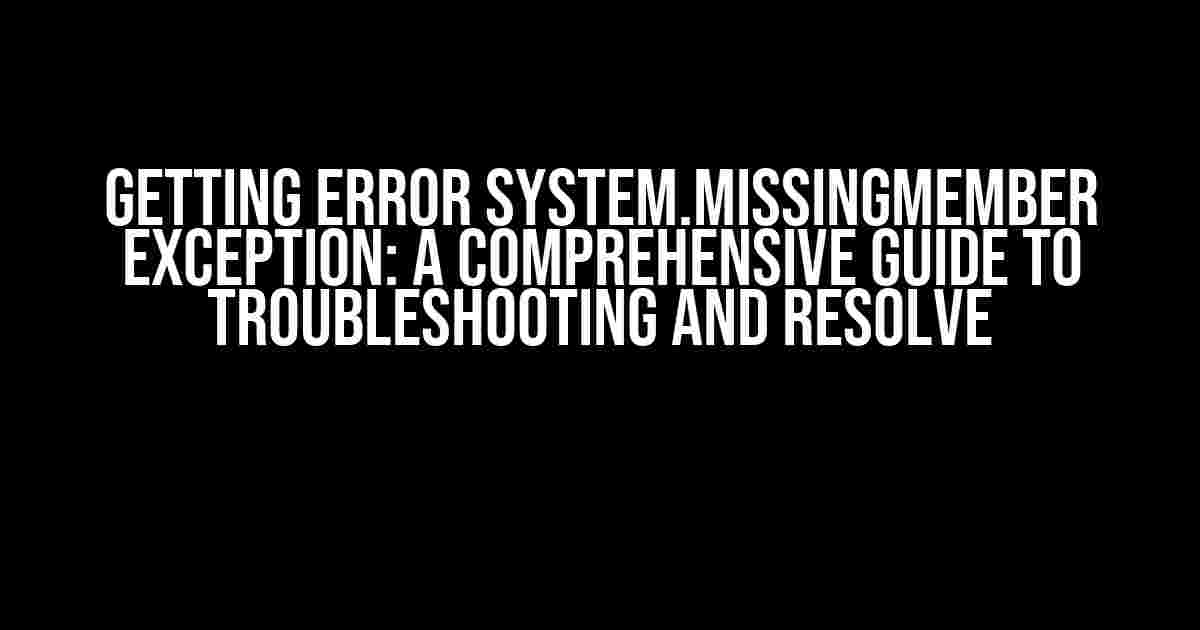The System.MissingMember exception is a frustrating error that can bring your .NET application to a grinding halt. In this article, we’ll delve into the causes of this error, explore the common scenarios where it occurs, and provide step-by-step instructions to help you troubleshoot and resolve it.
What is the System.MissingMember Exception?
The System.MissingMember exception is a type of runtime error that occurs when your .NET application attempts to access a member (property, method, or field) that does not exist in a type or object. This exception is typically thrown when there is a mismatch between the expected and actual members of a type or object.
Common Scenarios Where System.MissingMember Exception Occurs
The System.MissingMember exception can occur in various scenarios, including:
-
Incorrect Type Casting: When you cast an object to a type that does not have the expected members, the System.MissingMember exception is thrown.
-
Missing Assembly or DLL References: If an assembly or DLL is missing from your project, the types or members in that assembly may not be available, resulting in the System.MissingMember exception.
-
Outdated or Incompatible Libraries: Using outdated or incompatible libraries can cause the System.MissingMember exception, especially if the library has changed or removed members.
-
Reflection and Dynamic Method Invocation: When using reflection or dynamic method invocation, the System.MissingMember exception can occur if the member does not exist or is not accessible.
Troubleshooting System.MissingMember Exception
To troubleshoot the System.MissingMember exception, follow these steps:
-
Check the Error Message: Carefully read the error message to identify the type and member that is causing the exception. This information will help you pinpoint the issue.
-
Verify Type and Member Existence: Ensure that the type and member exist in the specified assembly or DLL. You can use the Object Browser or Reflection to verify the existence of the type and member.
-
Check Assembly and DLL References: Verify that all required assemblies and DLLs are referenced in your project. Make sure that the references are correct and up-to-date.
-
Use the Fusion Log Viewer: The Fusion Log Viewer can help you diagnose assembly binding issues. This tool can reveal if there are any issues with assembly loading or binding.
-
Enable Runtime Debugging: Enable runtime debugging to get more detailed information about the exception. You can use tools like Visual Studio Debugger or runtime debugging libraries like debugdiag.
Resolving System.MissingMember Exception
Once you have identified the cause of the System.MissingMember exception, you can resolve it using the following solutions:
| Cause | Solution |
|---|---|
| Incorrect Type Casting |
Cast the object to the correct type or use the
|
| Missing Assembly or DLL References |
Add the missing assembly or DLL reference to your project. Make sure the reference is correct and up-to-date. Right-click your project in Visual Studio > Add > Reference > Browse > Select the required assembly or DLL. |
| Outdated or Incompatible Libraries |
Update the library to the latest version or use a compatible version. Verify that the library is compatible with your .NET framework version. Check the library’s documentation or vendor website for updates and compatibility information. |
| Reflection and Dynamic Method Invocation |
Verify that the member exists and is accessible using reflection or dynamic method invocation.
|
Conclusion
The System.MissingMember exception can be frustrating, but by following the steps outlined in this article, you can troubleshoot and resolve the issue. Remember to carefully read the error message, verify type and member existence, and check assembly and DLL references. By using the solutions provided, you can fix the System.MissingMember exception and get your .NET application up and running smoothly.
By following these guidelines, you’ll be well-equipped to handle the System.MissingMember exception and ensure your .NET application is robust and reliable.
Frequently Asked Questions
Stuck with the pesky System.MissingMember Exception error? We’ve got you covered! Check out these FAQs to get your code back on track.
What causes a System.MissingMember Exception?
A System.MissingMember Exception occurs when your code tries to access a member (like a method, property, or field) that doesn’t exist in the type you’re working with. This can happen when you’re trying to use reflection, serialization, or dynamics, and the member you’re looking for is missing or doesn’t have the correct access level.
How do I fix a System.MissingMember Exception?
To fix this error, you need to ensure that the member you’re trying to access actually exists in the type you’re working with. Check your code for typos, and make sure the member is public and not marked as internal or private. If you’re using reflection, serialization, or dynamics, double-check that you’re using the correct types and methods.
Can I catch a System.MissingMember Exception?
Yes, you can catch a System.MissingMember Exception using a try-catch block. However, it’s generally better to avoid the error in the first place by ensuring that the member you’re trying to access exists. If you do need to catch the exception, make sure to handle it properly and provide a meaningful error message or fallback.
Why do I get a System.MissingMember Exception when using reflection?
When using reflection, a System.MissingMember Exception can occur if the member you’re trying to access doesn’t exist in the type, or if the member is private or internal. Make sure to check the BindingFlags and MemberInfo objects to ensure you’re searching for the correct member. You can also use the GetMethods() or GetProperties() methods to retrieve an array of members and iterate through them to find the one you need.
How do I prevent System.MissingMember Exception in the future?
To prevent System.MissingMember Exception in the future, follow best practices such as coding against interfaces, using the correct types and members, and testing your code thoroughly. Additionally, use tools like Resharper or Visual Studio’s Code Analysis to catch potential issues before they become runtime errors.

